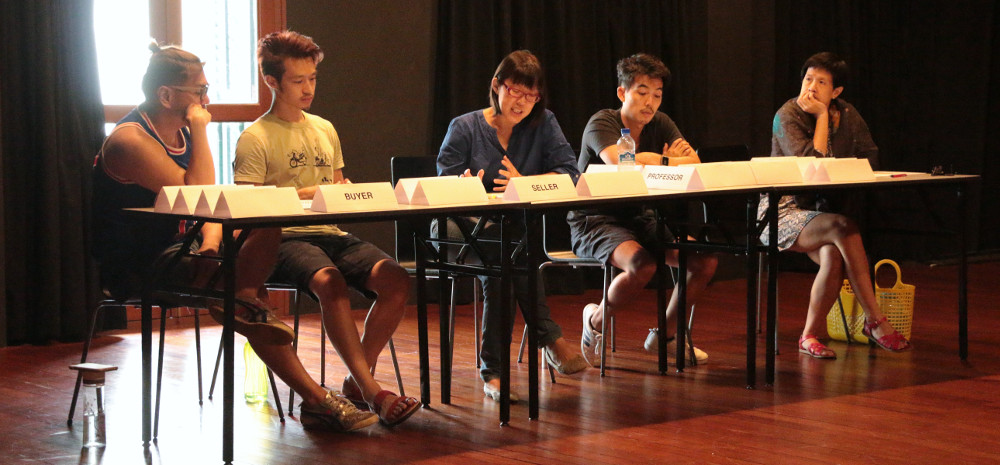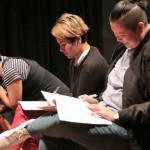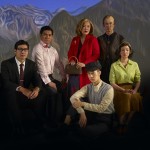Playwright Chong Tze Chien was the first artist to be supported by our Fellowship programme. In 2014, he wrote a play titled Starring Hitler as Jekyll and Hyde, which was restaged at Victoria Theatre from 13 to 15 October. Having decided that there’s a lot more he can explore about one of the most reviled men in history, Tze Chien decided to embark on an ambitious project: to create a trilogy that examines different facets of the dictator. The second play, called Framed, by Adolf (previously called The Fuhrer’s Work), questions what would happen if someone discovers a great piece of art by Hitler, who was an aspiring painter and architect in his youth. We ask Tze Chien to tells us more about the work, as well as the research and creative process behind it.
Why did you decide to write Framed, by Adolf?
I’ve always wanted to write a play about Hitler because both the history and the character fascinate me. I wrote the first play back in 2014 for a show at Lasalle, called Starring Hitler as Jekyll and Hyde. After that, I decided I wanted to write another piece – not a sequel, but a companion piece to that first play – and funnily enough Casey [Lim] and Robin [Loon] [Centre 42’s executive director and founding member respectively] approached me and asked if there was any other play that I wanted to write. That’s when I decided to do a trilogy based on this theme. I have no idea what the third play will be yet.
What was your research process like for this play?
I spent about 15 days in Poland and Germany to visit the Auschwitz concentration camps and the museums in Berlin in October 2015. By that time I had already read up quite a bit about Hitler and the history of the Holocaust, but to finally be there and walk on the grounds of the concentration camps put things into perspective.
How did the trip affect you?
It affected me on an emotional level, because you can read as many books as you want – and I’ve seen films like The Schindler’s List and other videos – but it’s very different once you get there. I arrived in Poland in the evening, and I booked the Auschwitz tour for the very next morning. It was raining, it was cold, and it was very crowded and touristy, actually. But once we stepped into the concentration camp, we were silent. We were just looking at all the different exhibits and listening to the tour guide telling us about the various sites and the history and the stories and you could feel the sorrow, you could feel the stories, you could feel the screams and the human drama as though they were still plastered onto the walls.
What were some of the stories that inspired the play?
It’s all very sketchy, but I found this story – which was turned into a film [called Europa Europa] – about this Polish Jewish boy who ended up in a Nazi youth camp by accident, and actually escaped the war by posing as a Nazi. It’s a fascinating, charming story.
You decide to examine Hitler from the perspective of art in Framed, by Adolf – why?
Because at that time, I had already written a play about the Holocaust, and I wanted to take on a more contemporary approach with this second work, so I decided to look at his art. I wanted to see how people look at Hitler’s painting these days, and I tried a few leads and asked quite a few people, but no one wanted to talk to me about it. I tried to find a museum that would house Hitler’s paintings, and I couldn’t find one. I just find it fascinating to have this failed artist to turn into the man that we know today, and to see the tyranny of his work as a politician, which interestingly enough is founded on art principles. Because if you look at the way that he orchestrated his rallies, the way that he drew his uniform, and the way he wanted to remake Germany, he was a man who wanted to turn the world into an artistic state. He wanted to build galleries and museums – and do everything that I as an artist would want. Which is why, as an artist, I’m fascinated by how politics and art could mix and form this rhetoric.
Could you tell us more about Hitler’s paintings based on your research?
They all look about the same! He was very meticulous, and his paintings are all nice and pretty – they’re mostly of pastures and architecture, since he was also an aspiring architect. But the one thing that kept surfacing – and the reason why he was rejected as a visual arts student when he tried to enrol into an art school – is that he couldn’t paint human subjects. He couldn’t paint portraits. If you examine his paintings, all his humans are almost like children’s drawings. Which is why in the play, I decided to have the seller discover a a rare painting of a human subject by Hitler that is drawn well. And that triggers the story from that point onwards.
How did you develop the characters in the play?
I had this image in my head of a Hitler painting with two sides – one is a painting of pastures that we’re very familiar with, and the other side would be a painting that nobody would know Hitler for – a human portrait. I want to ask what would happen if we discover a great Hitler painting. How would that rewrite art history, and how would that rewrite Germany’s history? And if we were to discover that great piece of work, would we reassess our opinion of him, and the war, and the Holocaust? So then that gave birth to the other characters. I wanted an auctioneer, I wanted a buyer, and I wanted a professor. And I needed someone to drive the play, so I needed someone to sell this painting, which became the daughter who inherited the painting from her father – who was the Jew posing as a Nazi. So it kind of wrote itself in that way.
What was the writing process like?
The first draft was written quite quickly. I came back from my trip to Poland and Germany last November, and started writing in January this year. I wrote the first draft in three days because I already had all these thoughts in my head. It just flowed. I didn’t look at it again until last month, when I picked it up again, relooked at it and cleaned up some things.
Why is it important for you to tell this story?
A few months ago someone actually wrote in – because we had already posted news about Starring Hitler as Jekyll and Hyde – and I assume that she’s Jewish, but she said, “this is not your history, so why are you writing about this and claiming this as your own?” But I feel that this story and this character still resonate now, and everything that was going on in 1930s Germany – like xenophobia and racism – is still happening today. I guess it’s strange for an Asian to want to write a story about Hitler and that part of history, because I don’t think many people talk about it even in Europe, based on the conversations that I’ve had. The first questions people ask are always, “why do you want to write a play about this? Aren’t there other Asian stories you can touch on?” But I don’t see it as an Asian’s take on a European history. I just see it as a human take on a story of us, as humans, and that’s all there is to it.
The read on this Friday (9 September 2016) is the first time that the play is read out to an audience – what are you looking to get out of that?
Responses. This is a first draft and it’s a way to help me consolidate my thoughts and put all these ideas and experiences into words, so I’m curious to see how people respond to it. I’m hoping to stage the play in 2018.
Interview by Gwen Pew and Daniel Teo
A closed door read of The Fuhrer’s Work (now renamed Framed, by Adolf) will be taking place on 9 September 2016 as part of Chong Tze Chien’s research process.






